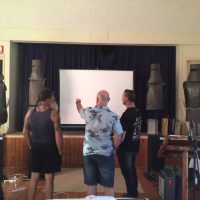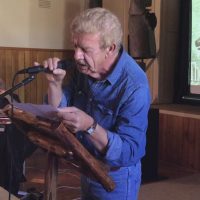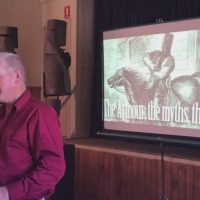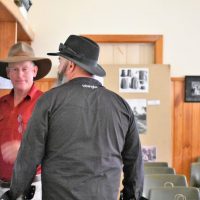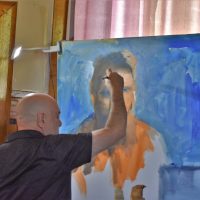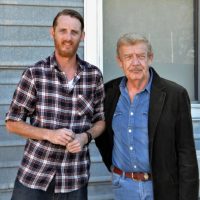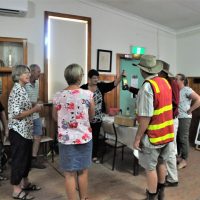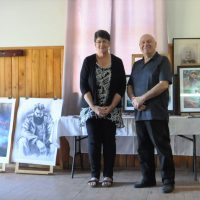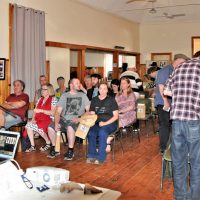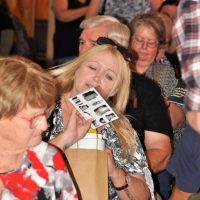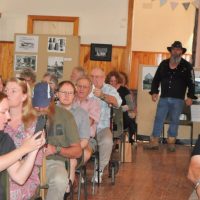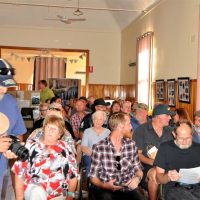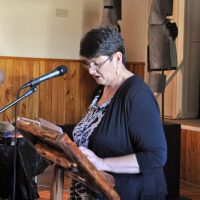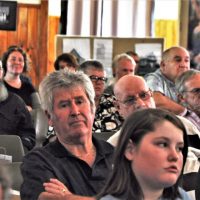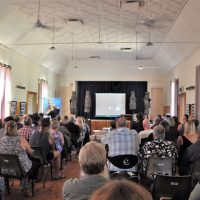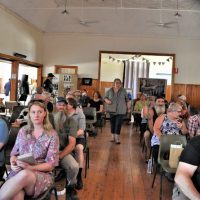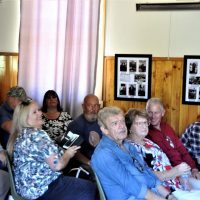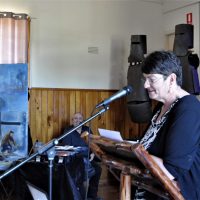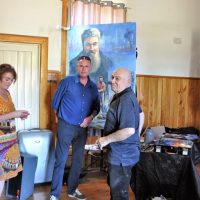Kelly Gang Armour: The Myths, The Facts
Noeleen Lloyd
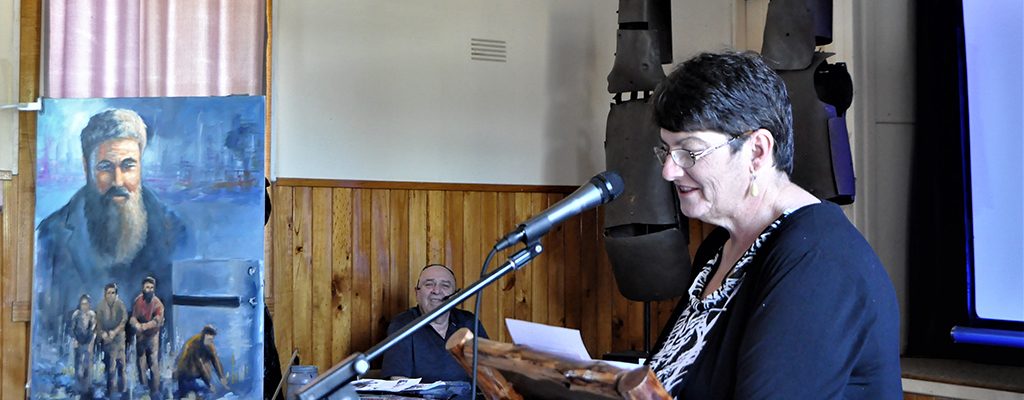
Greta Hansonville Hall, Saturday 23 March 2019
The Armour: the myths, the facts… was held on Saturday 23 February 2019 at the Greta Hansonville Hall. Discussions focused on the Kelly Gang’s armour – how it was made, why it was made, and the impact it has had on history, folklore, and popular culture. One of the presenters was committee member and local identity Noeleen Lloyd who spoke about the origins of the armour and why it was created. Noeleen is a direct descendant of Tom Lloyd Jnr, Ned\’s trusted and much loved cousin, who was often referred to as the fifth Gang member.
Introduction
While we are meeting in the original Greta Hall, it hasn’t always been on this site. Completed at the end of 1914, the Hall was opened at the end of harvest in March 1915, at the same time the Greta Hansonville district was farewelling men to the First World War. Several years earlier another hall had been opened further south at Hansonville. In 1952, however, a bushfire which had started on the outskirts of Benalla swept through the district and burnt the Hansonville Hall to the ground.
As a gesture of goodwill, and as part of the healing process, the Committees of both Halls met with district residents; it was decided to use the insurance money from the Hansonville Hall to unite the two Committees into the Greta Hansonville Hall Committee and physically move the Hall to its present, central location. This Hall has been used as a place for weddings, wakes, birthdays, christenings, sporting functions, and to both farewell and welcome back the men of the district in various theatres of war. It has been well used, it is unique, and it is ours. Your contributions here today will assists us in ensuring that the history and the heritage of the district remains alive and relevant by making sure our Hall remains sustainable and viable.
The Armour
‘Well it\’s your fault; I always said this bloody armour would bring us to grief.’ – Joe Byrne reportedly telling Ned Kelly what he thought about the armour, and overheard by Constable Phillips as he crouched near the Glenrowan Inn during the height of the Siege – this conversation was recounted by Superintendent Hare at the 1881 Victoria Police Royal Commission.
The armour is the stuff of myth and legend, it is what sets this story on fire – it is still talked about today, and it’s what we are talking about today. Ned Kelly’s last stand, that final hurrah as he walked from the bush, clad in armour, beating on his chest with a pistol, exhausted, wounded, and bleeding – beaten in body, but not spirit, it is the moment where he would grow from ‘outlaw’ to ‘Ironclad outlaw.’
‘I saw the police suddenly turn around from the hotel… that is the police on the northern side of the hotel, and fire into the bush. Upon looking in that direction I saw a figure bearing down on them which of course proved to be Ned Kelly in his armour. Senior Constable Kelly was on the northern side of the hotel at the time – Guard Dowsett joined him in the bush and they both made their way toward Ned Kelly. On would advance to a tree while the other kept Ned Kelly covered with his rifle, at least Dowsett was only armed with a revolver, but Constable Kelly kept Ned Kelly covered with his rifle and then Dowsett would keep Kelly covered till Senior Constable Kelly advanced and thus they approached Kelly. Meantime other policemen were advancing and forming a semi-circle around the bushranger. They fired at him for about fifteen minutes, without making any impression, now and then he staggered, but still advanced firing.’
Such was the statement by Joseph Melvin to the Kelly Reward Board on 11 March 1881. Joseph Melvin was a reporter for The Argus and had arrived in Glenrowan aboard the special train carrying the police from Melbourne. He was in the perfect position to report on the event, and provided a clear and telling description of Ned’s last stand. What is particularly important is his description of Ned appearing from the bush and smoke in his armour, undeterred. One man advancing and challenging dozens, in final, and very dramatic showdown. Why wouldn’t this story grow into a legend?
The armour – where was it made, who made it, how was it made and, why was it made? These are the questions that have been asked, debated, and never really answered since that night in June 1880.
We know that it was made in secret, and what a well-kept secret it was. As Detective Wilson travelled through the greater Greta district after the siege in August 1880, he had one mission … find out who made the armour and bring them to justice. Despite an exhaustive search at the end of his time he reported back to his superiors, ‘I made my self-acquainted with relatives and sympathisers, and friends of the outlaws, and found that they either “did not know” or “would not disclose who the guilty person or persons who manufactured the coats of iron for the outlaws”.’ Detective Wilson had been on a fool’s errand. No one would divulge the names – to do so would be treason. It had been treason in the first place and they were all aware of the cost. Ned had warned them from the beginning.
The names Delaney, Culph, Straughair, Knight, Lloyd, and others have all been mentioned – as the years, and time, for persecution passed, some stories emerged. With their deaths, however, and that of Thomas Peter Lloyd’s, who was known as Tom Lloyd Junior, the secrets and the exact truth has gone with them to their graves. Was Ned’s made at the back of the Bald Hills? Was it made in a bush forge? Or was part of it made in loyal farmers and blacksmiths workshops? What about Joe’s armour? It looks so different? Joe’s was made in the Woolshed Valley. Did he really get the idea from a suit of Samurai armour? Where was Dan and Steve’s armour made?
Then there’s the myths – that there was only one set ever made, or that it was only Ned who had a helmet. Maybe there were more than twenty sets made and they are all still hidden in a dam. That Tom Lloyd, Dick Hart, Wild Wright, and Alex Gunn had suits made and that they still exist – all these rumours have been the topic of many a conversation including the claim that Dan made them all, or that a blacksmith in Glenrowan made them while Dan stood guard with a shotgun, as one man reported in the 1930s. All of these points have arisen over the years. Most, if not all have been proven to be false.
If I could ask a few questions they would be – Which of you men did it, and how? And why, WHY? Whose decision was it? What sparked the idea? Was it to start a Republic of the North East? Was it war – were they the vanguard for battle? Or were they just part of an ill thought out plan? I know I’m not alone in wishing I could have those conversations. In fact, I’m not ashamed to say I ask a certain fellow in the Greta Cemetery a question or two when I visit. But to this day Tom has remained silent. I won’t stop asking, just as I know he’ll continue to keep quiet.
The police had been warned of the possibility of armour, three times at least in writing, by school teacher turned spy, Daniel ‘Denny’ Kennedy, also known as the Diseased Stock Agent. Diseased Stock being the code name for the Kelly Gang. There is no doubt in regards to reports around the district of stolen or missing mould boards – and they are mould boards not plough shares (or shears) as some authors and commentators have mistakenly referred. To clarify, plough shears are the pointy pieces at the end of the mould board for digging into the earth.
The reports of missing mouldboards started in February 1880. In a letter dated 20 May that year, Kennedy had written to Commissioner Charles Nicholson of, ‘Missing portions of cultivators described as jackets are now being worked, and fit splendidly. Tested previous to using and proof at ten yards…..A break out may be anticipated as feed is getting very scarce.’ Nicholson recalled this correspondence during his evidence to the Royal Commission. But Kennedy’s warnings were dismissed as an ‘impossibility’. This was again verified during the 1881 Victoria Police Royal Commission. The authorities were warned that armour was being made, that it was to be used in a ‘raid’ but the information was dismissed. So, the armour was still made in secret, and the ‘secret’ held, as the police chose to dismiss it.
Not all the material was stolen. As early as August 1879, another school teacher turned spy, this time playing the dangerous game of double agent, James Wallace of Hurdle Creek, was known to have been driving around farms ‘buying scrap metal.’ Scrap metal indeed…
It has been estimated that it took eight mould boards to make one full set of armour, so allowing for ‘practice pieces’ and ‘those not quite right’, upwards of forty mould boards may have been used. Initially other material such as saw blades had been trialled, and discarded. Stolen mouldboards yes, but also donated and bought. One of those ‘stolen’ was from William Sinclair, who lived not far from where we stand today. Talking to his 95 year-old grandson recently, I was informed that they were a sympathetic family – a strong Methodist family, not Irish Catholic, yet they believed that there was a struggle against something bigger and to this day, supported Ned’s ideals.
The police continued to believe the armour idea was impossible, even during the siege. It never entered their minds that the reason their shots were ineffective was due to armour – not until Ned was brought down. The police recognised the figure in the fog and smoke as Ned from his voice, but they didn’t recognise that he was wearing armour, as they couldn’t see it. Today this seems ludicrous – but the siege started in the early morning, it was dark, and later there would be smoke from the enormous amount of gunfire. Black powder creates far more haze than the smokeless gunpowder used in the later years. Even the manufacturer of the plows, Lennon’s of Spotswood, couldn’t believe it was possible, discounting that his plows could be altered, but there it was ‘H Lennon, Melbourne. No 2’ stamped on a shoulder plate.
Why The Armour?
The armour had never been intended for use during a siege – there was never meant to be siege – and the reasons for that are well known. In a desperate act to draw a special police train to Glenrowan, Joe Byrne and Dan Kelly rode with a mad and bad plan to confront Aaron Sherritt. This plan relied on the police telegramming Melbourne and the train being sent to Glenrowan within hours. The tracks would be torn up, the train would derail, and the four men would stand atop the bank and fire down at survivors until they surrendered. The hostages would then be used as bargaining tool to get Ellen Kelly released. Deceptively simple. No leg protection needed, as their legs would be covered by the slope of the railway bank. Ironically it would be the lack of leg protection that would cost Joe Byrne his life – shot through the groin and bleeding out, and Ned, who would be brought down by shots to the knees and legs.
During the hours, then day and then night, spent waiting for the train to arrive, the armour was in plain sight. It sat in the back room of the Glenrowan Inn, waiting … it had been brought in from its hiding place at Greta in bags. It waited … whilst the men readied themselves talking to the sympathisers at McDonnell’s Tavern, and at other lookout points. It waited … cold pieces of iron that would, in the end, offer no lasting protection. It waited whilst Joe and Dan made their mad dash back from the Woolshed Valley, did Joe know that the plan was already wayward?
It waited as Ned talked with the hostages. When he sent home Thomas Curnow, it waited. The Gang had almost decided to leave, then they heard the police special train pull up – there was mad scramble to put on the armour; the hostages reported that they heard clanking, and then the four ironclad men emerged on to the front veranda of the Glenrowan Inn and exchanged fire with the police. Even when the bullets did not bring them down , there was no thought by the police as to why.
Some of the hostages would go on to describe the armour in their evidence given during the 1881 Victoria Police Royal Commission. They would write about it in letters to family and friends and give eyewitness accounts to local and Melbourne newspapers. James Reardon, one of the railway labourers replied to a long line of questions at the Royal Commission:
7736. Did the armour they wore seem to be similar?
— Yes. I noticed Hart’s armour under his coat
7737. Where did you see any armour at first?
— At the gate
7738. When?
— On the Sunday morning.
7739. When they first came to you, they had the body-plates on?
— Yes.
7740. Therefore, after they came, they must have ridden in that armour on horseback?
— Quite likely; Ned had it on at my place, and had a white coat on, and I noticed a hump on his back.
Joseph Ashmead, a local wrote, ‘At the time of the capture of Ned Kelly at Glenrowan, I had the novel experience of trying on the armour and saw distinctly the stain of sap from a green tree. This proved it had been made in the bush, and turned into shape on logs cut for purpose.’
The press immediately began to report on the armour, Thomas Carrington made his famous drawing right on the Glenrowan Railway platform. The photographer Oswald Madeley took photos of Dan and Steve’s scorched armour, taken from the ashes of the burnt Inn. He also took a photo of Constable Arthur wearing Ned’s armour. The only armour not to have been captured in print is that of Joe Byrne. Thanks to the telegraph, news and pictures flashed world wide – one can only imagine what would occur in today’s digital age. So the myth and the legend began to grow – from day one to the present.
After The Siege
In the days and weeks after the siege, the armour became the focus of the Victorian Police Force – for two reasons. Firstly, to find out who made it and bring them to justice. And, secondly, what to do with it? All property had been seized, especially the armour, but the souvenir hunting and collecting had started in earnest. Ned’s armour had been removed from him on capture, it was weighed on the Glenrowan Railway platform, ninety-seven pounds, or almost forty-four kilograms.
As for the shoulder plate blown off by Constable Gascoigne at the beginning of the siege, well, he went back, found it and hid it in the creek for later retrieval. After all, what a great trophy and talking point it would make! Joe’s armour was removed after his body had been carried from the burning Inn. It was taken to Melbourne Depot. Dan and Steve’s armour, was also bundled up and eventually taken to Melbourne.
Superintendent Hare made a claim within days – four to be exact. On 2 August he and Superintendent Sadleir began a terse correspondence about the spoils with Hare writing, ‘you promised from the first…’ , Sadleir refused stating, ‘that it was he who was entitled to any trophy of the Kelly’s.’ Hare fired back with, ‘I intend to take what I can get out of the affair.’ Hare wanted Ned’s armour.
By September 1880, Chief Commissioner Captain Standish, was seeking to have all four sets of armour located, positively identified, and delivered to him. They were not all in the one place at the Melbourne Depot, where they were meant to be – Joe’s was actually back at Benalla and there were still some ‘sacks of armour’ to make their way to the Commissioner’s office. Standish’s plan was to have them smashed up – there was to be no focus on criminals – as he was well aware of the fascination the armour already attracted. They could not become a symbol. They could not be something that sympathisers, supporters, and the public alike, could rally around or hold onto – the Gang must be remembered as criminals – not romantic figures.
The Beechworth Museum had requested a suit of armour for display. In reply, Standish wrote to Sadlier, ‘I entirely disapprove of this as its exhibition will keep up the disgusting Kelly – heroism & have a very detrimental effect on the rising generation. My intention is to apply at once to the Chief Secretary to have the four suits smashed up at once.’
The armour was already misidentified and mismatched. Some pieces remained in official hands, others in private hands. Constable John Kelly had souvenired Ned’s silk skull cap and initially refused to part with it. He was finally forced to ‘giving it up’ after experienceing some pressure. Thankfully, Standish was not allowed to have them destroyed – because they are national treasures, right? Well, the armour has certainly been fought over – does that make them a treasure?
Hare got his way – he retained a set of armour, he thought he was clever and got Ned’s. In reality he got Joe’s. Hare never complied with requests to send the armour to Melbourne. Even when organising an inventory Hare placed his name against one set. He was nothing if not confident – note I said confident, not competent. He would eventually leave Joe’s armour with the Clarke family of Rupertswood, along with Ned’s revolving rifle.
In a memo dated 24 November 1880, Nicholson was proposing that the armour be part of a museum – he had proposed that a Police Museum be set up similar to one already established in London. He believed such a museum, ‘Could display those objects held in Police custody that had belonged to notorious criminals.’ What a fine bounty these four sets of armour were turning out to be
In reality, the sets would become mixed up, misidentified, and displayed incorrectly for many years. They would be spread between the La Trobe Library, (now part of the State Library), Museum Victoria, and the Victoria Police. They would be lent out, used in movies and adverts, displayed, tried on, thrown in a sack and stored in garden sheds and horse stalls. They would be played with by children – some can recount those memories – who could have stolen them and probably should have (I think I would have). Joe’s was thought to be Ned’s, or was it Steve’s? Ned’s helmet was incorrectly identified as Steve’s until 2000. Steve’s has the name ‘Ned Kelly’ painted and covered over. It also has welding marks to repair damage.
They would eventually come together and be positively identified and reassembled correctly after years of work, much of it attributed to historians. However, a significant body of work was done by Barrister and historian, Ken Oldis. His research and advocacy was vital. One of his statements related to Ned’s armour was, ‘you wouldn\’t hang a Picasso upside down. But they\’ve even hung some of the pieces back to front!’ His advocacy led to all the Gang’s armour eventually being reassembled in its correct formation. Ned’s armour was finally moved to the State Library of Victoria, where it is exhibited today. Sadly, Ken died in 2016, or I would have had him here presenting, rather than me.
Where Are They Now?
Well, as I said, Hare was nothing but bloody-minded in his determination. He kept a suit that would be identified as Joe’s. He left it with the Clarke family of Rupertswood and a descendant of that family holds it today, Mr Rupert Hammond QC. Dan and Steve’s has been in the custody of the Victoria Police from the beginning and is on display at the Victoria Police Museum.
Ned’s suit belongs to the State Government and is part of the State Library of Victoria’s collection – usually on permanent display, but can’t be seen at the moment as they prepare it as part of a new exhibition. The shoulder plate was eventually reunited with Ned’s armour after some clear detective work tracked it down and correctly identified it. The silk skull cap is ‘missing’ and cannot be found in the Victoria Police collection. Hopefully it will turn up.
And, finally, people ask about getting the armour back to the families. Prior to the publication of the The Complete Inner History of the Kelly Gang, J.J. Kenneally wrote to Jim Kelly in May 1928, ‘The Police were not justified in seizing and retaining the four suits of armour. I understand that these armours is worth at present about 500 pound so that the two suits should bring you about 1000 pound. This sum would provide you with comforts in your old age.’ Kenneally was basing the ‘not justified’ in that the Gang were not outlaws during the period 9 February to the siege on 28 June 1880.
In the early 2000s at the request of a number of Hart descendants, retired Chief Justice, John Phillips, gave the following opinion, ‘It was in 1880 (and still is) the Common Law that Victoria Police were entitled to take and retain possession of any object relevant to one of their enquiries into criminal offences and subsequent court and other forensic proceedings. All of the gang\’s amour was taken possession of in this way. Objects of cultural heritage – and there can be no doubt Steve\’s Armour falls into this category – may be classified under the Act and the relevant Minister given wide powers as to their preservation. It is quite possible that the Victoria Police would set in train these procedures if an application for Letters of Administration was made.’
Link: Forging The Kelly Gang Armour by Nick Hawtin

